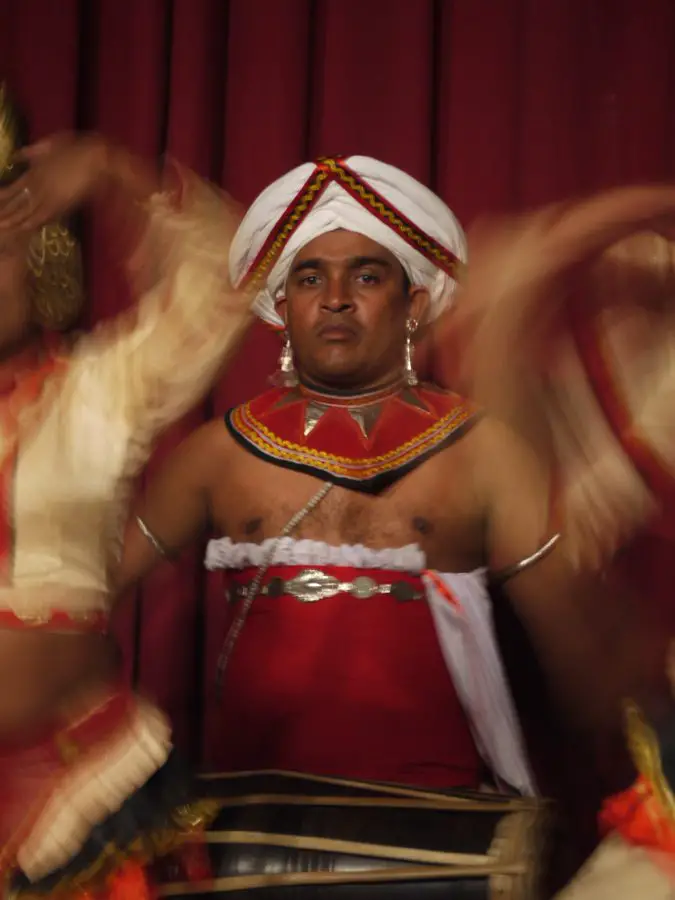Pregnant Monitor Lizard, Kandy, Sri Lanka
Winding up the roads towards Kandy, Sri Lanka’s self-proclaimed ‘cultural capital’, the change in temperature was becoming more and more obvious as the breeze coming in the windows grew cooler. Chatting with our new Welsh friend, Reese, we tried to keep our balance on the busy bus while consulting our guidebook for the best place to stay at our first stop in the island’s hill country. It’s always exciting arriving in a new place; through reading about it and what you hear from other travellers along the way you always have a picture of the place in your head prior to arriving and this time around was no different. Reese had visited briefly a few weeks previously and warned us that Kandy was more developed than what we might have expected with a Pizza Hut and KFC in the centre of town.
After ‘getting down’ from the bus we quickly negotiated a fare with a waiting tuk-tuk driver, piled in and zoomed towards Saranakara Road, a steep hill lined with various accommodation options and restaurants, at the southern end of Kandy Lake. Going from door to door we were losing all hope of finding reasonably priced accommodation we finally found what turned out to be a highlight of Kandy, the Glen. A real diamond in the rough, the lovely little guesthouse run by an elderly couple could only remind you of a weekend with Granny and Grandad. The three rooms in the family home were probably the nicest we had seen in Sri Lanka and it was the sole reason we extended our stay in the ‘cultural capital’. Wrecked from our long journey, a short stroll around the expansive Kandy Lake was all it took to knock us out for the night.
Strolling into the town centre the following morning we were stopped in our tracks by a local man to point out an enormous pregnant monitor lizard basking in the sun on the shore of the lake, an interesting start to the day! Kandy is one of the major stops for every kind of tourist to Sri Lanka, from backpackers to tour buses and everything in between and so we set off exploring to see what all the fuss was about. Our first stop was the colourful local fruit markets, going from stall to stall haggling for prices and admiring the displays and range of spices on offer. Following through the markets we ended up in the tourist section where prices were driven high by the vendors there was no reasoning with them so we left, giving them no business. Shopping at local markets as much as possible and trying to live on as close to a local price as possible you learn the true price of things in a country and this kind of behaviour can be infuriating. As a traveller you have to expect a bit of a mark-up but when you are treated like a walking ATM it can put a negative slant on your experience when you are overcharged for everything because of the colour of your skin. Shaking it off as best we could, we continued on our way.
Kandy’s main attraction, the Temple of the Sacred Tooth Relic, lies on the northern side of Kandy lake. The temple is famous with Buddhists the world over as it houses the tooth of the Buddha. On our way into the temple grounds we met a group of visiting monks from Myanmar who happily posed for pictures with us, in return for a few shots of us with them. Surrounding the main temple are a number of smaller buildings with different shrines and a giant holy tree which pilgrims walk around in clockwise direction three times, praying as they go.
Entering the main temple in time for the evening puja, we removed our shoes and made our way from room to room following the audio guide. A crowd began to gather as two men, bare-chested, wearing sarongs began playing flutes and banging drums to mark the beginning of the puja. The music continued as the crowd of tourists grew bigger as we made our way upstairs to join the queue of people to see the Buddha’s tooth. Locals carried offerings of flowers, money and fruit, anxiously waiting to get close to one Sri Lanka’s most important Buddhist relic. Monks in orange robes stood solemnly outside the door of the chamber in which the tooth was housed and a number of women sat cross-legged on the floor, singing and chanting throughout the entire procession. As the doors opened, cameras were raised and the gold casket was officially on display. Moving quickly the line of people were ushered past as they were given a glimpse of the dagoba shaped, golden casket in which the tooth is kept. It all happened very quickly and with true precision but despite the circus of tourists jostling for a view, there was a real air of divinity about the temple. It had grown dark while we were inside and exiting the temple past lit candles we could see the illuminated standing Buddha on a hill on the other side of Kandy.
With Reese moving on, it was back to just the two of us and we planned on visiting the tea museum a few miles outside of town. The overcharging which we had grown accustomed to in Sri Lanka didn’t wain and so we refused the seemingly hundreds of offers from tuk-tuk drivers to drive us and went in search of the public bus. Jammed with school children making their way home we were packed in like sardines and laughed as the bus stopped numerous time to fit on more passengers, it seemed like an impossible task but there were inches of space that we just didn’t see. The friendly conductor called us as we approached the museum and we hopped off to walk up to the 1925 vintage Tea Factory. Included in the ticket was a tour and with no other tourists about we had the place to ourselves. Irish people are big tea drinkers and we are no exception, however neither of us had ever given much thought to what goes into a cup of tea. Modernising in the last number of years most of the processes are now automated. However most tea leaves are still handpicked in countries such as India and Sri Lanka creating a highly labour intensive process which was fascinating to learn about inside the building which itself was a tea factory before being converted into a tea museum.
On our last evening in Kandy we went to the Kandy Cultural Performance and we were pleasantly surprised as the performers showcased the different dances from different areas of Sri Lanka. Each dance was distinctly different involving both male and female performers and a number of very impressive acrobatic moves. The highlight of the show however came when the hall of people were moved outside to watch as the small Sri Lankan men walked bare-foot through flames and across hot coals without wincing. For us, it was the last of our cultural experiences in the ‘cultural capital’, the next morning it was onto the train for what is known as one of the most beautiful train rides in the world, through the hill country and the lush green tea fields of Sri Lanka.

Brian is a travel writer, photographer, blogger, travel addict and adventure-junkie. Being outdoors, getting off the beaten track and outside his comfort zone is what makes him tick. Brian’s the dreamer in the relationship; when he’s not travelling, he’s dreaming about it! Keeping fit, cooking, music and red wine take up the rest of his time.
Sign up for our free travel photography Ebook "Faces of Nepal" and you'll also receive our monthly newsletter.











an interesting article about sri lanka kandy tea museum